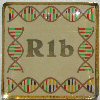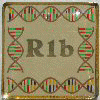
 Charles Kerchner's
Charles Kerchner's
YDNA Haplogroup Descriptions & Information Links
The following Haplogroup Descriptions are from the FamilyTreeDNA.com website which was the
testing company used to determine the nearest Haplogroup assigment based on the individual's
haplotype results from the Y-DNA paternal line test. These verbatim Haplogroup Descriptions and/or excerpts
are copyrighted by FamilyTreeDNA.com and all rights to these descriptions are claimed by FamilyTreeDNA.com.
These descriptions have been printed here with the permission of FamilyTreeDNA.com. These
descriptions cannot be used elsewhere without the written permission
of FamilyTreeDNA.com.
Kerchner's Haplogroup vs. Haplotype - What is the Difference Report
Your yDNA Male Line Haplogroup can often be suggested with high confidence from your Y-STR Haplotype.
But only a Y-SNP test can 100% confirm your Haplogroup. See above report for more details.
Check out the Y-DNA Haplogroup Pins
See the Genetic Genealogy DNA Testing Dictionary
Jump to mtDNA Haplogroup Descriptions Page
YDNA Haplogroup Migration Map from FTDNA (2006)
Origins, age, spread and ethnic association of European haplogroups and subclades - with map
R1a: The R1a lineage is believed to have originated in the Eurasian Steppes north of the Black and Caspian Seas. This lineage is believed to have originated in a population of the Kurgan culture, known for the domestication of the horse (approximately 3000 B.C.E.). These people were also believed to be the first speakers of the Indo-European language group. This lineage is currently found in central and western Asia, India, and in Slavic populations of Eastern Europe.
Origins, age, spread and ethnic association of European haplogroups and subclades - with map
Dennis Garvey's YDNA Haplogroup R1a1 Webpage
R1a yDNA Haplogroup Project
R1a SNP Results Table by John McEwan
FTDNA's DNA Testing Discussion Forum - Looking for an R1a Expert Thread
R1b: Haplogroup R1b is the most common haplogroup in European populations. It is believed to have expanded throughout Europe as humans re-colonized after the last glacial maximum 10-12 thousand years ago. This lineage is also the haplogroup containing the Atlantic modal haplotype.
Origins, age, spread and ethnic association of European haplogroups and subclades - with map
Dennis Garvey's YDNA Haplogroup R1b Webpage
Kerchner's R1b yDNA Haplogroup Project
R1b yDNA Haplogroup Project Discussion Group
Whit Athey's R1b Information Page and Super Western Atlantic Modal Haplotype Page
John McEwan's Summary of Public Results of Y-DNA Haplogroup R1b and SNP S21 Tests Project
R2: Haplogroup R2 originated in South Asia and is generally found in Central Asia, Turkey, Pakistan, and India.
Haplogroup R2 Project at FamilyTreeDNA
I: Haplogroup I dates to 23,000 years ago or longer. Lineages not in branches I1a, I1b or I1c are found distributed at low frequency throughout Europe.
Origins, age, spread and ethnic association of European haplogroups and subclades - with map
Dennis Garvey's YDNA Haplogroup I Webpage
Rootsi paper about the yDNA haplogroup I
Ken Nordtvedt's Population Varieties within Y-Haplogroup I and their Extended Modal Haplotypes
Andrew Lancaster's Report about Y-DNA Haplogroup I1* Clusters
I1a: The Haplogroup I1a lineage likely has its roots in northern France. Today it is found most frequently within Viking / Scandinavian populations in northwest Europe and has since spread down into Central and Eastern Europe, where it is found at low frequencies.
Origins, age, spread and ethnic association of European haplogroups and subclades - with map
Andrew Lancaster's Report about Y-DNA Haplogroup I1* Clusters
Haplogroup I1a Project at FTDNA
Rootsi paper about the yDNA haplogroup I
I1b: The Balkan countries likely harbored this subgroup of I during the Last Glacial Maximum. Today, this branch is found distributed in the Balkans and Eastern Europe, and extends further east with Slavic-speaking populations.
Origins, age, spread and ethnic association of European haplogroups and subclades - with map
Haplogroup I1b Project at FTDNA
Rootsi paper about the yDNA haplogroup I
I1c: Haplogroup I1c Project at FTDNA
Origins, age, spread and ethnic association of European haplogroups and subclades - with map
E: Haplogroup E Homepage
E3a: This haplogroup is an African lineage. It is currently hypothesized that this haplogroup dispersed south from northern Africa within the past 3000 years, by the Bantu agricultural expansion. E3a is also the most common lineage among African Americans.
Dennis Garvey's YDNA Haplogroup E3a Webpage
E3b: This haplogroup is believed to have evolved in the Middle East. It expanded into the Mediterranean during the Pleistocene Neolithic expansion. It is currently distributed around the Mediterranean, southern Europe, and in north and east Africa.
Origins, age, spread and ethnic association of European haplogroups and subclades - with map
Dennis Garvey's YDNA Haplogroup E3b Webpage
E3b Haplogroup Project with FamilyTreeDNA
The World Wide E3b Project, Open to All E3b's
E3b yDNA Haplogroup Project Discussion Group
F: YDNA Haplogroup F.
YDNA Haplogroup F Wiki Page
G and G2: This haplogroup may have originated in India or Pakistan, and has dispersed into central Asia, Europe, and the Middle East. The G2 branch of this lineage (containing the P15 mutation) is found most often in the Europe and the Middle East.
Origins, age, spread and ethnic association of European haplogroups and subclades - with map
Dennis Garvey's YDNA Haplogroup G Webpage
Whit Athey's Y-DNA Haplogroup G Website
Diagnostic Y-STR Markers in Haplogroup G by Phil Goff and Whit Athey
Peter Christy's YDNA Haplogroup G Project at FTDNA
The G SNP Project
J: Haplogroup J is found at highest frequencies in Middle Eastern and north African populations where it most likely evolved. This marker has been carried by Middle Eastern traders into Europe, central Asia, India, and Pakistan. The Cohen modal lineage is found in Haplogroup J*.
Dennis Garvey's YDNA Haplogroup J Webpage
J2: The J2 lineage originated in the northern portion of the Fertile Crescent where it later spread throughout central Asia, the Mediterranean, and south into India. As with other populations with Mediterranean ancestry this lineage is found within Jewish populations.
Research note: Many people new to Genetic Genealogy think the J2 haplogroup is synonymous with having male Jewish ancestry. One should note that having a J2 haplogroup assignment does not necessarily indicate Jewish ancestry. The J2 haplogroup is far more ancient than the Jewish religion and is found in many lines with Mediterranean region ancient ancestry.
Another relatively more recent mode for J2's entry into some parts of Europe from the Mediterranean areas could have been the Roman Legions and Roman settlements.
Origins, age, spread and ethnic association of European haplogroups and subclades - with map
Costa.Tsirigakis's J2 YDNA Project
N: N This haplogroup is distributed throughout Northern Eurasia. It is the most common Y-chromosome type in Uralic speakers (Finns and Native Siberian). This lineage most likely originated in northern China or Mongolia and then spread into Siberia where it became a very common line in western Siberia.
Origins, age, spread and ethnic association of European haplogroups and subclades - with map
Robert Anderson's Y-DNA Haplogroup N Project
Dienekes Haplogroup N Dissection Page
Dienekes Haplogroup N Link
K: The K lineage is an old lineage presently found only at low frequencies in Africa, Asia, and in the South Pacific. One descendant line of this lineage is restricted to aboriginal Australians, while another is found at low frequency in southern Europe, Northern Africa, and the Middle East. .
K2: The K2 lineage is an old lineage presently found only at low frequencies in Africa, Asia, and in the Middle East. This specific line is found at low frequency in southern Europe, Northern Africa, and the Middle East. Famous People in History Who Were in the K2 Haplogroup: Thomas Jefferson.
Gareth Henson's YDNA K2 Haplgroup Project
Thomas Jefferson's Patrilineal Origin per post in Dienekes' Anthropology Blog
Q: The Q lineage is the lineage that links Asia and the Americas. This lineage is found in North and Central Asian populations as well as Native Americans. This lineage is believed to have originated in Central Asia and migrated through the Altai / Baikal region of northern Eurasia into the Americas.
Rebekah Canada's Haplogroup Q Project
Dienekes Haplogroup Q Dissection Page
Q3: This haplogroup is the only lineage strictly associated with Native American populations. This haplogroup is defined by the presence of the M3 mutation (also known as SY103). This mutation occurred on the Q lineage 8-12 thousand years ago as the migration into the Americas was underway. There is some debate about which side of the Bering Strait this mutation occurred on, but it definitely happened in the ancestors of the Native American peoples.
C: Haplogroup C is found throughout mainland Asia, the south Pacific, and at low frequency in Native American
populations. Haplogroup C originated in southern Asia and spread in all directions. This lineage colonized New Guinea,
Australia, and north Asia, and currently is found with its highest diversity in populations of India.
Ed Martin's Y-DNA Haplogroup C and C3 Project
C1: The C1 lineage is entirely restricted to Japan where it occurs at low frequency.
C2: The C2 lineage is distributed throughout the Polynesia, Melanesia, New Guinea, and Indonesia.
C3: This lineage is believed to have originated in southeast or central Asia.
This lineage then spread into northern Asia, and then into the Americas.
Ed Martin's Y-DNA Haplogroup C and C3 Project
O1: This haplogroup is found at very high frequency in the aboriginal Taiwanese (possibly due to genetic drift).
This haplogroup probably originated in East Asia and later migrated into the south Pacific.
Individuals carrying this lineage are thought to have been important in the expansion of the Austronesian language group
into Taiwan, Indonesia, Melanesia, Micronesia, and Polynesia.
O2: Haplogroup O2 has two primary lines, the 465 line and the M95 line. Both lines are found in Asia.
The 465 line is at high frequency in Japanese and Korean populations and at low frequency in east Asia.
The M95 line is found in Southeast Asian populations (Malaysia, Vietnam, Indonesia, and southern China).
H: This haplogroup is nearly completely restricted to India, Sri Lanka, and Pakistan.
ISOGG's Y-DNA Haplogroup H and Subclades Information Page
L: This haplogroup is found primarily in India and Sri Lanka, and has also spread into several Middle Eastern populations (Turks, Saudis, and Pakistanis).
Gareth Henson's Y-DNA Haplogroup L Project
Marco Cagetti's Y-DNA Haplogroup L Webpage
P: The undifferentiated P lineage is a very rare haplogroup in populations at this time. Although it was the ancestral line to haplogroups Q and R it is only found at low frequency in India, Pakistan, and central Asia with a most likely point of origin in either central Asia or the Altai region of Siberia.

 mtDNA Haplogroup Descriptions
mtDNA Haplogroup Descriptions
Order a MtDNA Haplogroup Pin
Order a Genetic Genealogy DNA Testing Dictionary
Kerchner DNA Testing & Genetic Genealogy Info and Resources Page
Copyright ©2003-2021
Charles F. Kerchner, Jr.
All Rights Reserved
Created - 6 Jun 2003
Updated - 04 Feb 2021

 Charles Kerchner's
Charles Kerchner's